人腦對運動的辨識是一個很大的問題,目前來說沒有完整解決。僅僅探究認知上人腦的運動檢測功能,或許並不能完整的解釋人腦對運動辨識的高可靠性。還需要知道人眼的凝視(gaze)能力和該能力的實作的神經基礎。而這一點,正是目前我們在電腦的運動追蹤中很少被考慮到的。
1.視覺通路(Visual Pathway)與視網膜拓撲對映(Retinotopy)
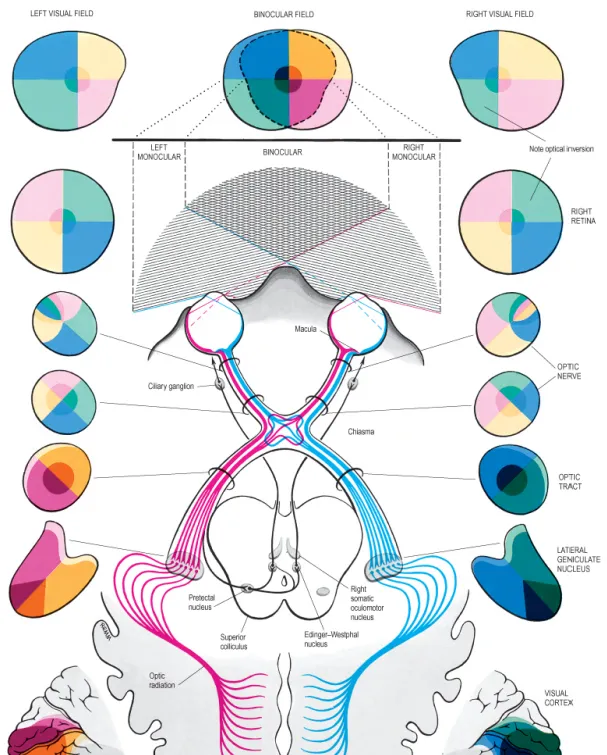
上圖是橫斷面的人腦視覺通路[1]示意圖。人眼的所有眼各有鼻側和顳側視野,在視網膜(Retina)感知光訊號之後,左右兩側的視神經將訊號向後傳遞,在視交叉(Optic Chiasma)將各自的鼻側和顳側訊號分流並繼續向後傳遞,分流之後左側神經只傳遞右側視覺訊號(左眼鼻側視野和右眼顳側視野),右側神經質傳遞左側視覺訊號(左眼顳側視野和右眼鼻側視野),分別透過兩側的外側膝狀體(LGN, Lateral Geniculate Nucleus),繼續傳遞到枕葉的初級視皮層(V1, Primary Visual Cortex)和更高級的視皮層. 易於理解的,視網膜感知的物體,透過該通路,會以一定空間關系對映視皮層上[2], 該關系被稱為視網膜拓撲對映(Retinotopy)[3].
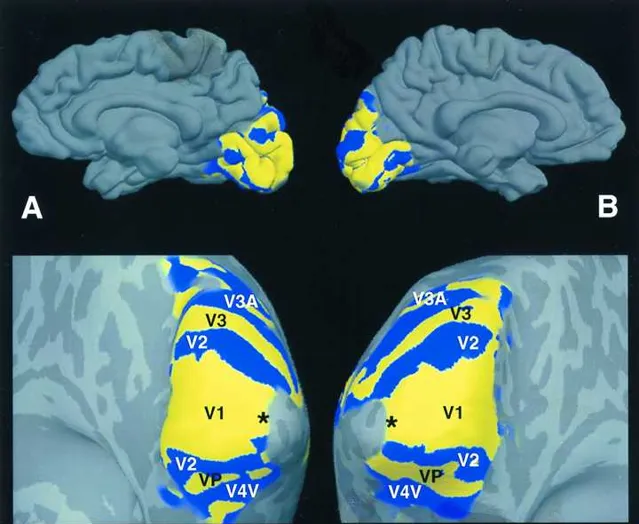
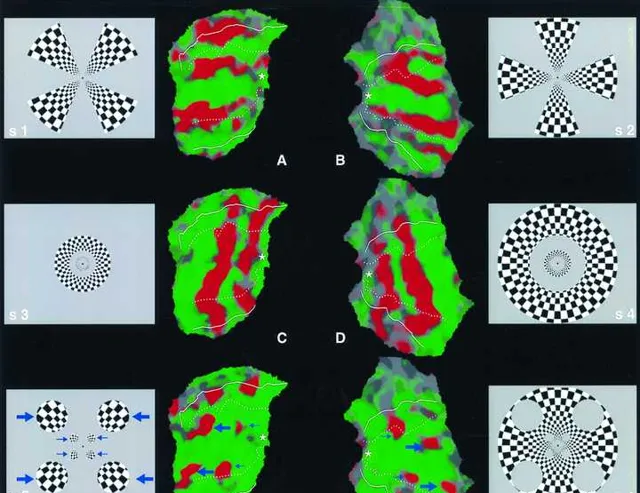
基於該拓撲關系,人們甚至可以透過搜集視皮層的fMRI訊號來重建人眼看到的文字/圖像,即所謂Mind Reading[4-7].

2.視覺皮層的分級結構和並列結構
視覺訊號傳遞到V1之後,會繼續向更高級的視覺皮層傳遞,最早在根據獼猴(Macaque Monkey)視皮層的解剖結果,人們重建了其各個視皮層之間的分級結構[7]:

以此為基礎,逐漸理解了人的視皮層分級結構:

從初級到更高級的視覺皮層,視覺資訊逐級傳遞。人腦理解的內容越來越復混成、抽象化,由「模式」變成具體的"物",再到物的特性和物與物之間的關系。在逐級傳到過程中,人們也註意到,其在皮層的傳到可以大體分成兩個通路,腹側通路(Ventral Pathway/Stream)和背側通路(Dorsal Pathway/Stream)[8]。
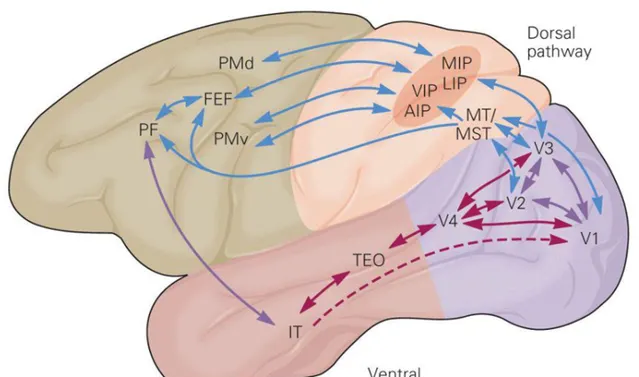
分別又按照功能,被稱作「What」和「Where」通路:
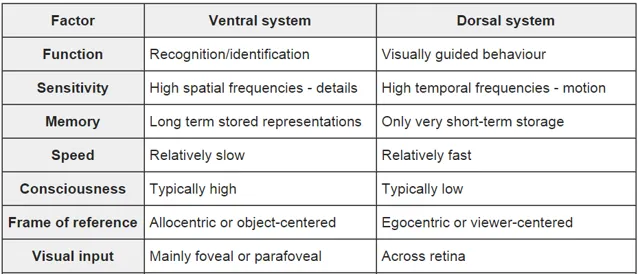
其中 「Where」跟物體的位置和運動處理有關,「When」跟物體的辨識有關 [9]。但是該模型仍廣受批評。

3.辨識與跟蹤
透過以上對分級結構的了解可以理解,在分級結構中任何一個區域的功能受損,都會影響人腦對運動的辨識和跟蹤,各種研究也證實了這一點[10-14]。人對運動的感知和理解,並不是局限在某一個腦區或者幾個腦區,而是全腦參與的活動[15]。人腦在運動處理上,除了有被動的運動感知,還有主動的運動追蹤,即凝視(共軛凝視,conjugate gaze)能力。
人有四個系統處理共軛凝視:
掃視系統 (saccadic system),最常呼叫的系統,在人主動的調整凝視方向時使用[16];
追蹤系統 (pursuit system),追蹤運動物體;
視動反射系統 (Optokinetic reflex system),物體出現在視野,眼睛會追蹤,當物體消失,人眼會反射性的回到凝視物體首次出現的位置;
前庭-眼 反射系統 (Vestibulo–ocular reflex system),協調頭部的運動以獲得穩定的影像,是眼睛的「三軸穩定平台」。
因而人眼就像一台高靈敏度、快速聚焦、快速響應、三軸穩定的攝影機,目前人類還造不出在對焦能力上足以和人眼比肩的攝影機,更別說做到跟眼睛同等體積了。人腦在運動辨識及追蹤處理上,目前區別於電腦運動辨識追蹤的重要一點是, 人腦的辨識追蹤是即時的,並能反饋控制眼睛的主動追逐。 在該機制下,透過「where」和「what」通路處理的資訊,會傳遞到額葉眼領域(FEF, Frontal eye fields)等眼動控制中心,作出眼球運動響應。該機制因此有如下優點:
在目前沒有能力如此強大的攝影機機的背景下,目前做的電腦運動辨識追蹤主要是基於被動影像的處理,即不會根據處理結果調整聚焦和鏡頭方向。在該條件下,對追逐演算法引入學習能力,仍然可以大幅提高追蹤速度和準確性,如Tracking-Learning-Detection (TLD) [17]方法:

在圖像理解方面,人腦的影像理解既有 bottom-up機制,又有top-down機制,兩種相互助益。
在圖像模態方面,可以多模態結合,彌補網路攝影機沒有回看能力的缺陷。
在計算方面,分布式計算以提高即時性。
如果能將計算結果反饋給網路攝影機控制,可能大有幫助。
以上
--------
[1] Standring, Susan. "Gray’s anatomy." The anatomical basis of clinical practice 39 (2008).
[2] Tootell R B H, Hadjikhani N K, Vanduffel W, et al. Functional analysis of primary visual cortex (V1) in humans[J]. Proceedings of the National Academy of Sciences, 1998, 95(3): 811-817.
[3] Engel S A, Glover G H, Wandell B A. Retinotopic organization in human visual cortex and the spatial precision of functional MRI[J]. Cerebral cortex, 1997, 7(2): 181-192.
[4] Miyawaki, Yoichi, et al. "Visual image reconstruction from human brain activity using a combination of multiscale local image decoders." Neuron 60.5 (2008): 915-929.
[5] Kay, Kendrick N., and Jack L. Gallant. "I can see what you see." Nature neuroscience 12.3 (2009): 245-245.
[6] Stanley, Garrett B. "Reading and writing the neural code." Nature neuroscience 16.3 (2013): 259-263.
[7] Van Essen, David C., and John HR Maunsell. "Hierarchical organization and functional streams in the visual cortex." Trends in neurosciences 6 (1983): 370-375.
[8] Kandel, Eric R., James H. Schwartz, and Thomas M. Jessell, eds. Principles of neural science . Vol. 4. New York: McGraw-Hill, 2000.
[9] Ungerleider, Leslie G., and James V. Haxby. "‘What’and ‘where’in the human brain." Current opinion in neurobiology 4.2 (1994): 157-165.
[10] Grossman, Emily, et al. "Brain areas involved in perception of biological motion." Journal of cognitive neuroscience 12.5 (2000): 711-720.
[11] Vaina, Lucia M., et al. "Functional neuroanatomy of biological motion perception in humans." Proceedings of the National Academy of Sciences 98.20 (2001): 11656-11661.
[12] Grossman, Emily D., and Randolph Blake. "Brain areas active during visual perception of biological motion." Neuron 35.6 (2002): 1167-1175.
[13] Grezes, Julie, et al. "Does perception of biological motion rely on specific brain regions?." Neuroimage 13.5 (2001): 775-785.
[14] Saygin, Ayse Pinar. "Superior temporal and premotor brain areas necessary for biological motion perception." Brain 130.9 (2007): 2452-2461.
[15] Rokszin, Alice, et al. "Visual pathways serving motion detection in the mammalian brain." Sensors 10.4 (2010): 3218-3242.
[16] Robinson, D. A. "The mechanics of human saccadic eye movement." The Journal of physiology 174.2 (1964): 245-264.
[17] Kalal, Zdenek, Krystian Mikolajczyk, and Jiri Matas. "Tracking-learning-detection." Pattern Analysis and Machine Intelligence, IEEE Transactions on 34.7 (2012): 1409-1422.











